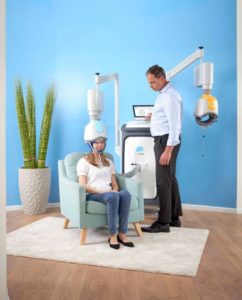Transcranial Magnetic Stimulation (TMS) is a noninvasive treatment that uses magnetic fields to regulate the activity of brain structures found to be related to different mental health conditions. As the treatment itself relies on repeated pulses of magnetic fields, it is sometimes referred to as repetitive TMS, or rTMS.
At present, there are two major kinds of TMS therapy publicly available to treat mental health conditions: the above-mentioned Traditional rTMS; and the more advanced Deep TMS™. The two share certain similarities while differing in other regards, with Traditional rTMS being the first type of TMS on the market, and Deep TMS being the only medical device with clinical outcomes data FDA-cleared to treat obsessive-compulsive disorder (OCD) and smoking cessation.
Both Traditional rTMS and Deep TMS are a noninvasive form of therapy that activates a series of electromagnetic pulses that reach different areas of the brain, either directly or through its internal neural pathways. Repeated over time, these pulses eventually create a regulatory effect within brain structures found to be associated with a number of mental health conditions, helping normalize their neural activity. This in turn helps reduce the frequency and severity of the condition’s symptoms. While Traditional rTMS has a narrower range of activation, Deep TMS manages to safely reach deeper brain structures directly, which contributes to its higher level of efficacy.
Various studies have shown that both Deep TMS and Traditional rTMS are safe and effective courses of treatment. A randomized, controlled study published in Clinical Neurophysiology determined that the safety of Deep TMS was comparable to that of a sham group and to Traditional rTMS. Both forms of TMS were also shown to be well-tolerated and not cause any significant physical or neurological side effects.
Traditional and Deep TMS have been found to grant symptom relief to those facing the adverse symptoms of mental health conditions. A 2019 study published in the Journal of Psychiatric Research confirms this: the study, which focused on patients battling major depressive disorder (MDD), concluded that both Deep TMS and Traditional rTMS caused significantly higher rates of remission when combined with medication, as opposed to medication alone. Studies like this underscore TMS’s efficacy in treating symptoms of mental health conditions, in addition to its ability to be integrated with other forms of therapy.

There are several key differences between Traditional rTMS and Deep TMS. These include the scope of their magnetic field activation, their level of treatment efficacy, and their FDA clearance status.
Scope of Magnetic Activation
Due to their differing equipment and technology, the magnetic fields created by Traditional and Deep TMS differ in their size and scope of activity. Traditional rTMS relies on a figure-8 coil design, which only reaches a depth of 0.27” (0.7cm). Deep TMS, however, uses a more three-dimensional H-coil helmet design, which manages to encompass a broader surface area and stimulate deeper brain structures directly, reaching a significant sub-threshold of 1.25” (3.2cm). These results were shown in a 2014 Brain Stimulation study. Deep TMS’s advantage lies in its combined ability to not only directly regulate deeper structures linked to mental health conditions, but also to safely target more of these crucial structures during each session. This is because Deep TMS’s magnetic fields spread over wider areas of the brain, while Traditional rTMS’s fields are activated through a narrower prism, increasing the risk of missing relevant brain structures. For the coils designed to treat depression, the H-coil stimulates approximately 17cm3 of brain matter, while the figure-8 coil stimulates approximately 3cm3.
Putting it simply, Deep TMS’s wider scope of activation reduces the likelihood of targeting issues, thereby increasing its efficiency.
Since brain structures are not located in the exact same spot for everyone, it is imperative to make each session count. Indeed, recent studies have pointed to the fact that managing to regulate more of the relevant structures can lead to a decrease in symptoms, resulting in a greater quality of life.
Level of Treatment Efficacy
As Traditional rTMS and Deep TMS’s use different equipment whose magnetic fields reach different depths and ranges within the brain, the two treatments end up affecting patient symptoms with different levels of efficacy. An independent* 2019 study published in the Journal of Psychiatric Research found the difference between both treatments to significantly favor Deep TMS, noting that patients with moderate-to-severe baseline depression reached higher rates of response under a treatment course that combined Deep TMS and medication, when compared to either Traditional rTMS and medication, or medication alone.
*The Magstim® Rapid² device was used in this study. (Magstim Company, Spring Gardens, UK)
FDA Clearance Status
Traditional rTMS first received its FDA clearance status to treat MDD in 2008. Deep TMS received its FDA clearance status for treating MDD in 2013, was FDA-cleared to treat OCD in 2018, and FDA-cleared to treat Smoking Cessation in 2020. BrainsWay is working to expand Deep TMS’s clearance status, to treat additional brain disorders and addiction behaviors with its proven effective technology.
Deep TMS has also received the European CE certification mark for its treatment of a number of additional mental health and neurological conditions. Receiving the CE mark of approval confirms that Deep TMS meets the health, safety, and environmental benchmarks of products, services and devices sold within the European Economic Area (EEA).
As a result, Deep TMS has been CE-marked to treat the following conditions: MDD, OCD, Alzheimer’s disease (AD), autism, bipolar disorder, chronic pain, multiple sclerosis (MS), Parkinson’s disease, post-stroke rehabilitation, post-traumatic stress disorder (PTSD), the negative symptoms of schizophrenia, and smoking cessation.
With an advanced product that uses cutting edge technology to offer greater results to patients and professionals, it is clear why BrainsWay is leading the charge when it comes to safe, effective and study-backed treatment options for those who need it.